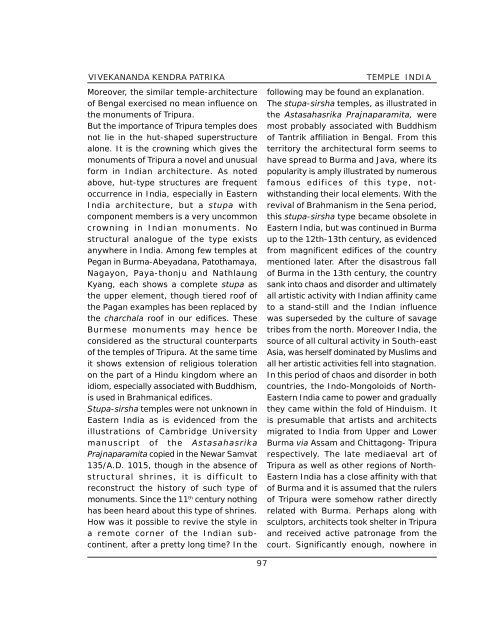Temples In India-1.pdf - Vivekananda Kendra Prakashan
Temples In India-1.pdf - Vivekananda Kendra Prakashan
Temples In India-1.pdf - Vivekananda Kendra Prakashan
You also want an ePaper? Increase the reach of your titles
YUMPU automatically turns print PDFs into web optimized ePapers that Google loves.
VIVEKANANDA KENDRA PATRIKAMoreover, the similar temple-architectureof Bengal exercised no mean influence onthe monuments of Tripura.But the importance of Tripura temples doesnot lie in the hut-shaped superstructurealone. It is the crowning which gives themonuments of Tripura a novel and unusualform in <strong>In</strong>dian architecture. As notedabove, hut-type structures are frequentoccurrence in <strong>In</strong>dia, especially in Eastern<strong>In</strong>dia architecture, but a stupa withcomponent members is a very uncommoncrowning in <strong>In</strong>dian monuments. Nostructural analogue of the type existsanywhere in <strong>In</strong>dia. Among few temples atPegan in Burma-Abeyadana, Patothamaya,Nagayon, Paya-thonju and NathlaungKyang, each shows a complete stupa asthe upper element, though tiered roof ofthe Pagan examples has been replaced bythe charchala roof in our edifices. TheseBurmese monuments may hence beconsidered as the structural counterpartsof the temples of Tripura. At the same timeit shows extension of religious tolerationon the part of a Hindu kingdom where anidiom, especially associated with Buddhism,is used in Brahmanical edifices.Stupa-sirsha temples were not unknown inEastern <strong>In</strong>dia as is evidenced from theillustrations of Cambridge Universitymanuscript of the AstasahasrikaPrajnaparamita copied in the Newar Samvat135/A.D. 1015, though in the absence ofstructural shrines, it is difficult toreconstruct the history of such type ofmonuments. Since the 11 th century nothinghas been heard about this type of shrines.How was it possible to revive the style ina remote corner of the <strong>In</strong>dian subcontinent,after a pretty long time? <strong>In</strong> theTEMPLE INDIAfollowing may be found an explanation.The stupa-sirsha temples, as illustrated inthe Astasahasrika Prajnaparamita, weremost probably associated with Buddhismof Tantrik affiliation in Bengal. From thisterritory the architectural form seems tohave spread to Burma and Java, where itspopularity is amply illustrated by numerousfamous edifices of this type, notwithstandingtheir local elements. With therevival of Brahmanism in the Sena period,this stupa-sirsha type became obsolete inEastern <strong>In</strong>dia, but was continued in Burmaup to the 12th-13th century, as evidencedfrom magnificent edifices of the countrymentioned later. After the disastrous fallof Burma in the 13th century, the countrysank into chaos and disorder and ultimatelyall artistic activity with <strong>In</strong>dian affinity cameto a stand-still and the <strong>In</strong>dian influencewas superseded by the culture of savagetribes from the north. Moreover <strong>In</strong>dia, thesource of all cultural activity in South-eastAsia, was herself dominated by Muslims andall her artistic activities fell into stagnation.<strong>In</strong> this period of chaos and disorder in bothcountries, the <strong>In</strong>do-Mongoloids of North-Eastern <strong>In</strong>dia came to power and graduallythey came within the fold of Hinduism. Itis presumable that artists and architectsmigrated to <strong>In</strong>dia from Upper and LowerBurma via Assam and Chittagong- Tripurarespectively. The late mediaeval art ofTripura as well as other regions of North-Eastern <strong>In</strong>dia has a close affinity with thatof Burma and it is assumed that the rulersof Tripura were somehow rather directlyrelated with Burma. Perhaps along withsculptors, architects took shelter in Tripuraand received active patronage from thecourt. Significantly enough, nowhere in97
















